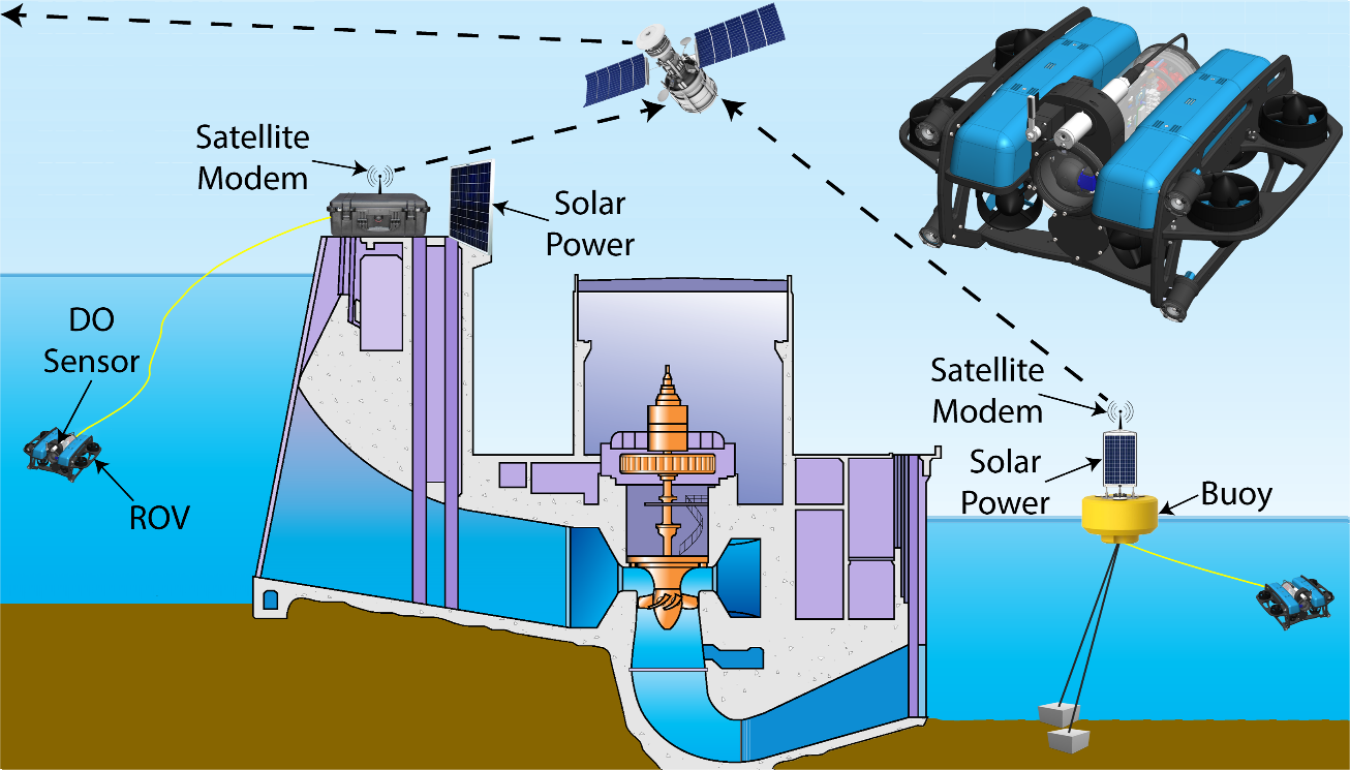In late 2019, PNNL’s new autonomous, mobile, water quality sensor platform was field-tested for the first time.
Water Power Technologies Office
January 13, 2021In fall 2019, a new autonomous, mobile water quality sensor platform for measuring dissolved oxygen was rigorously field- tested at an operational hydropower plant in North Carolina for the first time. The new sensor package, developed by PNNL under WPTO’s Real-Time and Autonomous Water Quality Monitoring System project, takes water quality measurements in difficult and sometimes dangerous environments around hydropower intakes and discharges and enables safer, timelier, and a more complete picture of dissolved oxygen levels at hydropower plants. The technology was put into practice at a hydropower facility in North Carolina, where the system monitored the performance of a newly installed aerating turbine. Important partners in this collaborative effort included Eagle Creek Renewable Energy (Eagle Creek; formerly Cube Hydro) and General Electric (GE).
For Federal Energy Regulatory Commission (FERC) licensing, hydropower operators are often required to collect environmental data, which is an essential building block for optimizing environmental and energy operational outcomes. Data collection plays an important role in managing and mitigating the impacts hydropower operation can have on aquatic life, such as water temperature shifts and fluctuating levels of dissolved oxygen and nutrients in the waters upstream and downstream of the facilities. Maintaining levels of dissolved oxygen outlined in state water quality standards, for example, is crucial to the health of fish and other freshwater organisms, though it is often challenging during seasons of drought or when the facility is passing a large quantity of water through the turbines. Collecting more comprehensive water quality data, such as dissolved oxygen data, can help overcome this challenge; however, capturing these data points can be difficult because of the hazardous conditions near hydropower plants, particularly around intakes and tailraces.
Currently, water quality monitoring at hydropower facilities is limited by a lack of mobility. Most methods rely on a stationary buoy and sensor or a human worker to take measurements. This not only limits the selection of sampling sites but can pose safety risks during data retrieval and equipment maintenance. Additionally, reliance on a single point source measurement of water quality at a specified depth fails to provide data that present a complete picture of water quality throughout a water column at multiple locations.

Although many hydropower projects perform monthly dissolved oxygen sampling or retrieve hourly logged data during equipment maintenance visits, PNNL’s autonomous water quality monitoring system is based on a remotely operated vehicle that can travel to multiple depths and locations and features software that allows users to access real-time and historical sensor data. The data are displayed on a dashboard, so power plant operators can provide dissolved oxygen data in real time as needed to optimally operate aeration equipment for mitigating low dissolved oxygen levels.
The platform features two deployment schemes, allowing it to accommodate flow conditions from upstream and downstream dams:
- Dam structure-based deployment: The remotely operated vehicle is tethered from a station at the top of the dam—without using a buoy—with locations and depths along the face of the dam near the intake.
- Buoy-based deployment: The remotely operated vehicle uses a buoy as a docking station at a downstream location—at or very near the tailrace—to take measurements at any location not limited by the length of the vehicle’s tether and local flow conditions.
In late 2019, the technology was put into practice at Eagle Creek’s High Rock Hydroelectric Facility outside Charlotte, North Carolina. Situated on the Yadkin River, the High Rock facility had experienced difficulties in maintaining minimum levels of dissolved oxygen during seasons of drought or when the facility was passing water through its turbines for generation. To mitigate during periods of low dissolved oxygen, Eagle Creek implemented two measures: 1) adapting an existing spill gate to aerate spill and 2) installing GE’s new aerating turbine. The project team deployed PNNL’s water quality monitoring system to demonstrate how it can be used to assess the performance of these systems, allowing High Rock to more effectively monitor the dissolved oxygen and use the data to optimize turbine operations through digitalization. Data from the effort will also help GE to accurately assess the performance of its new aerating turbine to inform any future design changes.
Looking ahead, the team will conduct outreach to hydropower owners, operators, and other interested stakeholders to share advances and gather feedback on the prototype and present the resulting research findings. In 2021, PNNL, working in partnership with Southern Company, will also deploy the water quality monitoring system in the tailrace at Logan Martin Dam in Alabama.
For additional information, contact TJ Heibel.





